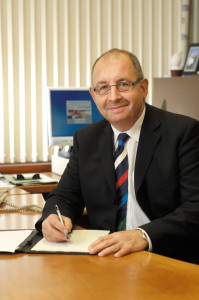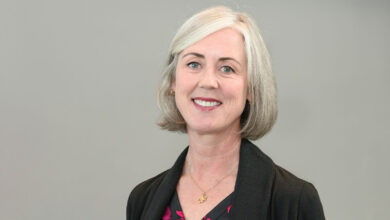Learning together in Ballymena
 Peter Cheney talks to Ballymena Academy headmaster Ronnie Hassard about how schools are working in the County Antrim town to tackle sectarianism and deliver the new curriculum.
Peter Cheney talks to Ballymena Academy headmaster Ronnie Hassard about how schools are working in the County Antrim town to tackle sectarianism and deliver the new curriculum.
As roll numbers fall and the choice of subjects on the post-primary curriculum increases, collaborative working between education providers is set to become a more important feature of Northern Ireland’s education system. Ballymena Learning Together is one example of a partnership where schools have been working together at a local level.
It is unique as it involves all the post primary schools in the Ballymena area: Ballee Community High School, Ballymena Academy, Cambridge House, Castle Tower, Cullybackey High School, Dunclug College, Slemish College, St Louis’ Grammar and St Patrick’s College.
Ballymena Academy’s headmaster, Ronnie Hassard, has been involved in the partnership since it was set up two and a half years ago to “consciously model” cooperative working, trust, mutual respect. “We have two goals really,” he explains. “The most significant one so far has been to make a contribution and improve leadership to efforts to improve community relations in the town, and the second is to provide a secure basis for collaboration for curricular purposes.”
The partnership was formed in 2006, before the Assembly was restored and at a time of political and sectarian tension in the town and in many other areas across the province. Ballymena, Mr Hassard is keen to point out, is not a special case when it comes to sectarianism but he acknowledges that it has been persistent.
“The young people in this town have been exposed for generations to strong negative influences from various groups and factions on both sides of the religious divide. The fact has been that the two communities have been driven apart. There’s just been mutual ignorance and suspicion, the effect of which was to ‘legitimise’ sectarianism.”
This ultimately led to the death of 15-year old Michael McIlveen in May 2006. He continues: “For a variety of reasons, before that incident and after it, there was no single organisation offering a cohesive or credible community relations platform for the town. There were lots of people and there was plenty of good work going on.
“In the place of that single cohesive voice, in that vacuum, sectarianism developed a momentum and we felt as principals: ‘We stand up in our various assemblies, we speak about respect and mutual understanding. Our schools are standing for these things and not for sectarianism.’
“We felt compelled, strategically, to say that the state of affairs was unacceptable and that we would work together with each other and with other agencies to give leadership to make this a more open and welcoming community, and a safer place in which to grow to adulthood.”
In its cross-community work, Ballymena Learning Together’s emphasis is that a person’s individual identity and cultural allegiances are not threatened by mutual understanding. The principals decided it was important to help as many young people in Michael’s year group – i.e. 1,000 pupils in Year 11 – tackle sectarian attitudes.
Ballymena Learning Together was constituted as an organisation, with the principals as its steering committee and George Campbell, then acting Chief Executive of Belfast Education and Library Board, as its co-ordinator. As schools’ resources were limited and there was no time to train staff to lead this kind of work, they sought outside help.
Mr Hassard asked the Common Purpose organisation to assist. While hesitant at first, due to the size and scale of the group involved, they agreed and came up with a plan for a series of workshops over three days and also one-day conferences known as Your Turn.
“We deliberately didn’t just pick out the best. We felt that this needed to reach all the young people. The focus was on the young person’s place in the community and understanding that community, but also understanding the contribution they can make to improve that community, and that programme was run very successfully for two years.”
Boards of governors and parents were told about what was going on, and a number of adults from the local community, such as businesspeople, local government officers and civil servants, were brought in to facilitate the workshops.
The Spirit of Enniskillen ran workshops for pupils aged over 16 and also organised a joint residential with pupils from all the schools. Commending its work, Mr Hassard adds: “Spirit of Enniskillen’s expertise and where it is truly excellent is in injecting an element of challenge and designing the challenge so that young people have to see their own identity and understand their own prejudices – the prejudices that we all have – and we value that contact very much.”
Ballymena Academy is the largest school in the town and sends some pupils to classes in the Northern Regional College, where they can study GCSE Construction and digital photography. A joint interschools programme on Key Stage 3 Citizenship and Employability is already taking place, and has taken pupils on visits to the Assembly and the Dáil. There are plans for more school-to-school cooperation to teach music and minority subjects.
The principals want Ballymena Learning Together to be a sustainable long-term programme with an established independent financial base. “Whilst our fundraising efforts have been successful, we are a long way from being sustainable at the moment,” Mr Hassard admits. To date, support has come from the Department of Education, Ballymena Borough Council, the Housing Executive, Wrightbus, the Black Santa Appeal, Guy’s Free School (a charitable organisation in Ballymena) and the Irish Department of Foreign Affairs.
“Sustainability also means succession,” he adds, pointing out that the current nine principals will not always be there. Each school has a designated member of staff responsible for their school’s role in Ballymena Learning Together and the partnership tries to involve as many members of staff as possible.
He has been impressed with the great enthusiasm and energy that young people have shown in the Your Turn workshops and the way in which they have generated ideas. The ‘Join hands for a better tomorrow’ posters which feature the logos of each school on palm prints were designed by young people.
“Quite frankly, what is difficult to get working well is collaboration for the Entitlement Framework and there are reasons for this,” he comments. “School timetables are different. Transport costs and takes time. There has been no problem about the pupils being in each others’ schools. To my knowledge, there have not been any instances of people reacting badly to pupils from other schools in each others’ corridors.”
Ballymena Academy is also the only school he knows which includes councillors and business representatives as of right on its board of governors, which helps to build its links with the wider community. The school has an extensive work shadowing programme and runs an annual careers fair for Year 10 pupils as they make their GCSE choices.
As well as its distinct accent and “the padlock on the wallet”, Mr Hassard sees Ballymena as a place where education is valued. There is strong parental support for schools and they tend to have high expectations, which bring their own challenges. In his opinion, the area is “collectively well served by its schools, at primary and post-primary level” and these schools are also “one of Ballymena’s greatest strengths”.





